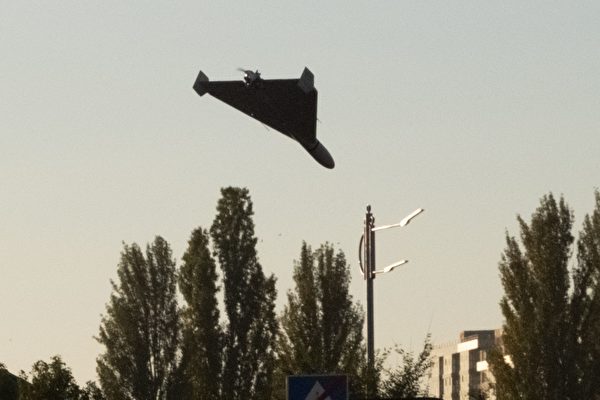Two European intelligence sources have revealed that Russia began producing a new long-range attack drone called “Garpiya-A1” last year, utilizing Chinese engines and components, as reported by Reuters. Documents seen by the news agency indicate that over 2500 Garpiya drones were produced by a subsidiary of the Russian state-owned arms manufacturer Almaz-Antey, IEMZ Kupol, between July 2023 and July 2024.
This information, including production contracts and financial documents, sheds light on the involvement of Chinese technology in Russian drone manufacturing, a development not previously reported. Both IEMZ Kupol and Almaz-Antey have not responded to requests for comments from Reuters.
The two sources disclosed that Garpiya, meaning “harpy” in Russian, has been deployed for attacks on military and civilian targets within Ukraine, resulting in damage to critical infrastructure and casualties among civilians and military personnel.
They provided Reuters with photos allegedly showing wreckage of the “harpy” from Ukraine, but did not offer more details. While information supporting this conclusion was found, the authenticity of these photos could not be independently verified.
Given the sensitivity of the information, the sources requested anonymity and emphasized the confidentiality of certain details, such as dates, related to the documents.
Samuel Bendett, a senior research analyst at the Center for a New American Security in Washington, told Reuters that if the existence of the “harpy” is confirmed, it would signify Russia’s reduced reliance on Iranian-designed long-range drones.
He remarked, “If this happens, it could indicate that Russia can now rely more on domestic development and clearly can rely on China, as both sides depend on many Chinese components in drone production during this war.”
Ukrainian President Volodymyr Zelenskyy had previously stated that since the start of the Russian invasion in February 2022, Iran had supplied over 1000 “Shahed” drones to Russia. These drones were used to deplete Ukraine’s air defenses and target infrastructure away from the frontlines.
The Russian Ministry of Defense did not respond to Reuters’ requests for comments. The Chinese Foreign Ministry, in a statement to Reuters, asserted strict control over the export of items, including drones, with potential military use, emphasizing China’s dedication to peaceful negotiations and political resolutions regarding the Ukraine crisis.
Furthermore, the statement highlighted that China’s trade with Russia is not restricted by international limitations.
NATO Secretary-General Jens Stoltenberg recently urged China to cease support for Russia in the war in Ukraine, pointing to Beijing’s assistance as a significant factor contributing to the ongoing conflict.
In another statement issued to Reuters, European agencies expressed concerns about the continued supply of Chinese components enabling Russia to produce large-scale suicide drones. The statement called for a halt to the export of critical components to Russia.
Washington has repeatedly warned Beijing to cease its support for Russian defense industries and has imposed hundreds of sanctions aimed at curbing Moscow’s ability to utilize certain technologies for military purposes. However, the State Department and the White House did not respond to Reuters’ requests for comments on the matter.
In July this year, China announced tightened export rules for drones starting from September 1st. Beijing denounced sanctions imposed by the U.S. on Chinese entities in response to the Ukraine conflict as “illegal and unilateral.”
According to the production contract between Kupol and the Russian Ministry of Defense, the “harpy” has a takeoff weight of under 300 kg with a maximum range of 1500 km, similar to Iran’s “Shahed-136” drone, widely used by Moscow in Ukraine.
Reports from The Washington Post in August revealed Russia’s plans to increase production of the domestically produced version of the “Shahed-136”, known as Geran-2, in the Alabuga Special Economic Zone in Tatarstan. Ukraine had previously claimed responsibility for a drone attack on a drone manufacturing plant in Alabuga.
Documents reviewed by Reuters revealed updates in delivery statuses between intermediary TSK Vektor and manufacturer Kupol in the first quarter of 2024, detailing orders for 100 axles, carburetors, and other Limbach engine components from two Chinese companies, Juhang Aviation Technology and Redlepus Vector Industries, both based in Shenzhen.
Juhang faced sanctions from the UK in February and the U.S. in May for supplying drone equipment to Russia. Redlepus did not respond to Reuters’ requests for comments.
Based on customs data obtained from a commercial supplier, from April 2022 to December 2023, TSK Vektor imported goods worth $36.3 million from the Chinese Juhang Aviation Technology and $6.2 million from Shenzhen Redlepus Vector Industries, including aircraft engines, transistors, electronic modules, connectors, plugs and sockets, spare parts, and components, most marked for “general civil purposes” and “general industrial purposes”.

